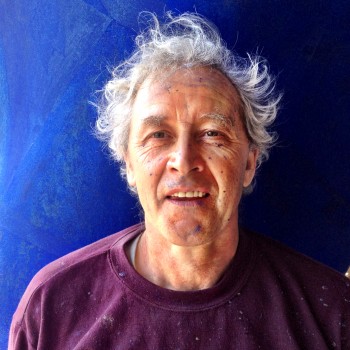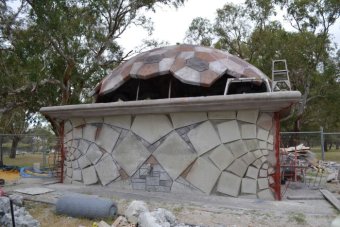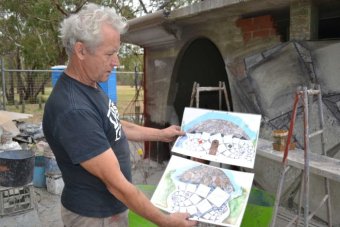Interview with the Featured Artist, Duncan Moon
conducted by Steve Parker
SP: Hi, Duncan, and thanks very much for agreeing to do the Triggerfish interview.
Perhaps we should start by getting a general overview of what you do. As I understand it, a lot of your work is ‘public,’ as in it’s displayed outdoors in areas where it’s accessible to the general public. Could you give us an idea of how you would categorise your work in this context, if that’s possible? And also could you tell us what sort of materials you use and how personally involved with everything you are? I think some of your art is quite large-scale, and involves a lot of physical work. Obviously, some artists design their works and then have them made by others, but I think you’re more involved than that. Could you give us an idea of how it all works and who it’s for, both in terms of who you see as the ‘end user’ of your work, and perhaps what sort of people commission it, if that’s possible?
DM: Yes I do go for the public artworks as we have a pretty healthy % for art scheme in Western Australia (up to 1% of the total cost of any public works) commissioned through the state, federal or local governments . Public art gigs are keenly sought after and hence competitive, therefore it’s not particularly profitable.
It’s quite a confrontational approach to getting your art directly to an audience and there’s an art in itself to negotiating the vicissitudes of public art and getting it right. It is about place and cultural currency articulated through the placement, siting and sighting of form and social substance. Public art has the power to unite communities and create a sense of civic pride, or equally it can divide and disrupt them.
The public, far from being an amorphous, homogeneous whole is more like a disparate, competing set of publics, and winning the popular approval of a majority of these groups will not guarantee critical acclaim – more likely preclude it! Somewhere (probably running for cover) in this rather dystopian sounding arena is one’s own sense of validation for the work, which of course is necessary to even contemplate doing a public artwork. But it is ‘the public’ in all their random glory who inherit the work when I sign off on a job. I do get a physical sensation of handing over the work and await the response….will it get vandalised?…..will it get a nickname? (they often do and they’re never complimentary)…will it be loved or loathed? etc…
I’m an autodidact artist principally a stone carver and stucco fabricator, I’m also a painter and draftsman. The approach I take is to do the work myself rather than have it fabricated by others as, although not very fashionable nowadays, I love skill and love the skills I have. If I contracted the work out to fabricators I couldn’t genuinely feel I had authorship of the work.
There is a wilful blurring of the lines in my work between artist and artisan, art and architecture, sculpture and structure and space and form. Stone requires little processing, it’s really a matter of stock removal and, as it involves working with the very flesh of the Earth itself, a variety of juicy images and adjectives come to mind. Stucco or more usually ferro-cement (modern day wattle and daub), is the cousin in the masonry idiom and is more plastic and cost effective. In either medium the work is hard physical graft – it’s dirty, dusty, hazardous and quite often repetitive and boring. If ever there was something that could dispel any fanciful notions of the work an artist being romantic, this would be it. However, I do get a buzz as the final shape emerges exactly as intended from endless drawings, templates, measurements and gauges.
Architectonic ideas, closely aligned with mathematical harmonies and geometric imperatives, unite physical, philosophical and aesthetic structures. These generally manifest in a formal vocabulary of topological, involute sensual lines on a monumental scale (that exceeds the human scale). Scale (as opposed to proportion) is something that the works seem to determine for themselves, and I often feel I have little say in the matter.
SP: Yes, I guess your work really is out there in that sense, Duncan, and potentially exposed to vandalism and abuse. Of course the flip-side of all that is the sheer exposure itself, and how many people get to experience what you’ve created. I guess people can use public art in a whole spectrum of ways, from the highly appreciative to the most base; and perhaps unlike most works of art, people in whatever community really do live alongside them and with them. It seems rather appropriate to link from that to your current work, which is the conversion of a rather uninspiring old toilet block into something which looks quite sublime (called ‘The Nearest of the Faraway Places’), and which perhaps most obviously bestrides and suggests two extremes of usage and appreciation (as your name for it illustrates). Could you tell us how that project came about? And I believe there’s now a phenomenon known as ‘toilet tourism.’ Is that a real thing, and where did it come from?
DM: The current project of transforming a grungy 1960s toilet block – a piece of shoebox infrastructure – into a public artwork has been commissioned by the City of Bayswater Council in Perth, Western Australia. The council had thought of demolition and installing a self-cleaning toilet, but were inspired by a similar project undertaken by the Austrian artist, Friedensreich Hundertwasser in Kawakawa NZ. The selection process was severe but I finally managed to get chosen.
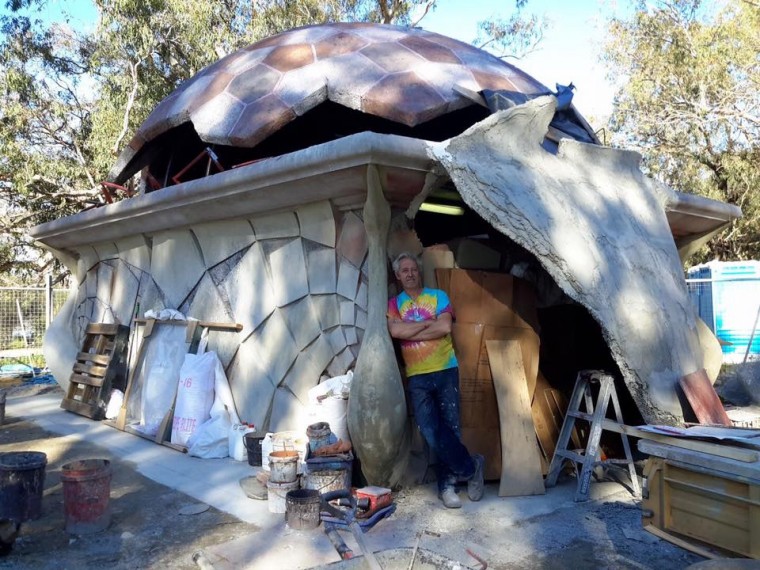 Duncan Moon, Work-in-Progress, The Nearest of the Faraway Places
Duncan Moon, Work-in-Progress, The Nearest of the Faraway Places
The success of the now famous Hundertwasser toilets in NZ is part of an emerging phenomenon known as toilet tourism. This is a more innocent practice than it may sound, whereby tourists visit toilets out of choice rather than necessity, and admire their architectural merit. There are some 20 or so examples of these facilities worldwide and the C of B wished to be part of the ‘movement’! I think their timing is immaculate as Perth has just become the gateway port into Australia for direct flights from London.
I’m unsure how toilet tourism came about, I tend to think that it just happened. People are inventive with their need for stimulation, and toilets had been largely overlooked till now. It’s easy to forget how important these perfunctory and often maligned buildings are. Good public health is essential and a lack of sanitation means the presence of diseases like cholera. Beyond accommodation and transport, two things tourists like to be of a high standard are internet connection and toilets.
SP: I believe there’s also such a thing as ‘bus-stop tourism,’ believe it or not, with the most ornate and inspired bus-stops in the world being along the ‘Silk Road,’ from the Stalin era (surprisingly), in places like Kazakhstan. But that aside, if you had complete freedom to do whatever you wanted in terms of sculpture/architecture, what would it be? And why?
DM: Great, a hypothetical / fantasy question which suits me fine, as it reflects the fact that 90% + of me is in that state, with only a small portion making it through to the exterior, physical world.
Complete freedom would still mean the same material palette of stone and stucco. It could see me in the studio making the proliferation of ideas in my head awaiting reification. These would be mostly figurative works – and I think it was Picasso who said that there’s only figurative work in art. I won’t be too specific about the actual substance of these ideas as someone reading this may just to decide to go and make this or that sculpture themselves. That, however, doesn’t really answer your question – so complete sculptural freedom would mean……
……constructing the ‘Australian Guggenheim Museum,’ creating building and sculpture as a singularity. There’s an old power station in Perth that has Guggenheim writ large across it and a transformational re-purposing would answer the pitiful, silent scream issuing from the building’s carcass.
The successful edification of an essential yet hideous piece of infrastructure into a social and artistic phenomenon would mean subverting the ‘form follows function’ maxim and breaking the first rule of ornamentation that states; ‘construction should be decorated, decoration should never be purposefully constructed’. Adolph Loos called ornament a crime; Mies Van der Rohe issued the edict that less is more; and finally Robert Venturi, mercifully, said less is a bore.
I would reinterpret bleak, rectilinear architecture with an hallucinatory strength that bends the square block of the building into sensual curvilinear expressions of form. As always I’d find the greatest freedom when bound by the intractable rules of proportion – limits are set and the possibilities within these fully exploited.
Why the Guggenheim – well, presently Australia doesn’t have one and it really ought to. I know as much about designing art galleries as I do about designing toilet blocks and am therefore admirably suited for the job!
SP: Well I’d definitely love to see that! I wondered about how much anyone manages to achieve the actual direction in art that they would choose if they had complete freedom. What, for instance, would Michelangelo or Borromini have done if they hadn’t been tied to religious commissions and sponsorship? Interesting that the examples (or the main one) you’ve given in reply would be big public things.
DM: Yes, or at least one big public thing and I’m still not sure if I answered your question or just jumped onto the nearest tangent because I got a whiff of fantasy and the question is not actually that easy to answer. However I don’t retract a word of what I said. In the first instance I said complete freedom would see me in my studio shed working away. It’s a rather pedestrian reply which relates more to financial freedom [i.e. 100% living off my art] and artistic freedom just happening of it’s own accord, which is true though not specific… The palette and conceptual drivers would be the same, just a more extreme version of what I’m currently doing.
Michelangelo would always go his own headstrong way, which infuriated Pope Julius II and various Medicis. The rampant nudity on the Sistine Chapel ceiling with figures, that although painted, behave like sculptures. He made no attempt whatsoever to represent any Medicis with correct portraiture. He dismissively said “who in a thousand years time would know what these people look like anyhow,” negating his chance to transmit that information to posterity. And then he turned canonical rule on its head and invented mannerism. Despite all of this free license he gave himself I don’t think Michelangelo, generally behind with his commissions (indeed he saw the commission to paint the Sistine ceiling as punishment for failing to deliver Pope Julius’ tomb on time) really saw himself as a free agent.
Both these men were idiosyncratic if not iconoclastic. Borromini, the temperamental stonemason turned architect, would be the one to put the inevitable twist in Renaissance architecture that would fully enunciate the Baroque. The Renaissance, being the first classical revival, in a way mimicked the geographical and psychological migration of classicism from the Hellenic to the Roman, or Greek to Italian peninsulas. As this occurred the moduli changed from the columnar and trabeated buildings in Greece to arcuated, more plastic Roman structures, with the wall as the modulus. It is this element of plasticity in Borromini’s work, his bending of structure, his Roman predilection for curvature, that let everyone know that the restraint of a previous generation of architects was no longer de rigeur.
SP: Going a bit further with this question, I’m wondering if now that you’ve achieved a number of significant public works (which has to carry some status), you’re now regarding the direction you’ve become involved in, or the more wishful fantasy side you’ve mentioned, as the most desirable and/or challenging, if that makes any sense.
DM: They’re all mingled together in some kind of trope for the creative process, a magical thinking that is kept at a more or less safe level – maybe that caveat alone precludes it from being such. If I were to discretely regard works done or being done as concrete and fantasies and ideas as abstract then the latter might become critically endangered, so both hold the same potency in every degree. As physical work is being executed mental work is being devised and both are regarded as equally real.
SP: I think I’m just trying to grasp how restrictive or non-restrictive any of it feels. Does it seem like a completely satisfying process, or do you find things being left behind, and do you pine for more freedom? I can definitely find it stimulating sometimes to have a set writing task to complete, as it can take my imagination to places it might not have got to otherwise – so despite the fact that commissions, which have some sort of clear demarcations about their parameters, might be useful in that sense, do you also feel constricted by them? What would be a typical commission process?
DM: So far I’ve found that I’ve had almost all the latitude I wanted in public commissions and concessions, if they’ve occurred at all, have been small. Though I can understand that I may have to be prepared to work under the external impositions of stake holders. So far the commissioning process has been a requirement to articulate a sense of place and a few themes are proffered. As yet I’ve not had the luxury of simply filling a space with ideas. I ruminate and grumble for a while and ideas begin to form and fall apart and reform etc. When I finally present my concept, I feel assured that I’m not compromised in any way, my integrity is intact and I’m ready for work.
However, further to my previous reply referring to the Australian Guggenheim, this notion of complete freedom has proved to be a bit of bug bear. It sounds like I would define this by shackling myself to a client with specific intentions and a demanding project that would keep me in some kind of indentured labour. So let’s have some complete freedom in this example…The Guggenheims are prepared to give me that space to fill with ideas because they like the fact that my name isn’t ‘Frank,’ and will also like whatever I design. In doing that I’d try to channel and distil an ancestral creative memory into a modern cultural current, cogent of the fact that I’m carrying a mantle of past endeavours into a future vision.
That still doesn’t sound like complete freedom. The question’s kind of stumped me and each time I try to reply I tend to find myself lying on the couch at a therapy session, both cursing and thanking you. Firstly I described complete freedom as a set of geometric limits from which I could derive manifold possibilities and secondly I described this condition as holding a grave responsibility. Perhaps I’m on day release and therefore value my freedom and this encourages my mind to soar. A derelict power station on the shores of the Indian Ocean would be an urban threshold onto which I could reinterpret a past essence into a future sense. The geometry, whether overt or covert, would provide (as Plato stated) “the ideal philosophical language”.
SP: Insincere apologies from me then for a deceptively simple and (unintentionally) complex question! I’m pleased that it elicited so much thought.
I’d quite like to dig further in to the technicalities at this point, if that’s okay. You mentioned mathematical harmonies above, and I have to say the idea of reworking a toilet block according to the principles of sacred geometry is a pretty fantastic collision of ideas, and sure as heck reminds us of the organic origins of art. Can you explain some of the mathematics to us? In an earlier conversation you suggested that a few details from Raphael might illustrate some of this. Could you enlarge on that idea? And feel free to baffle us a little here!
DM: I think I’d best describe my mathematical approach to composition as a mathematical ideation, as I’m certainly no mathematician. I love mathematical ideas and expressions, and know it is a language of patterns. It’s so natural for me to pick up a compass and straight edge, swing arcs and draw lines, thus gaining an understanding of and contemplating the complexities of my intended design. This is my entry point into any visual art undertaking ̶ generally as the idea develops so does the underlying geometry. Other times the geometry is complete from the outset, and the ideas flourish around these master lines.
Number(s) or proportion (a relationship not necessarily expressed in numerical terms) can exist in groups or as loners, they can be dynamic or static, irrational, transcendental, generative, whole or musical. They can be used in combination or singularly and they overlap. For example there’s the dynamic geometry of the root rectangles family. Based on the diagonal of a square (or part thereof) we can determine a golden mean rectangle and roots 2,3 and 5 dynamic rectangles. Root 4 rectangle is in there too but it’s whole-numbered and static. Root 4 is 2 and forms 2:4 rectangle; this is better expressed as 1:2 aspect ratio (length/ width) and that is an octave in musical terms (the contradictory relationship of half and double). Root 5 + 1 (i.e. one original square) divided in half makes 2 golden mean rectangles (those root rectangles are one busy little family!).
SP: Can we relate this specifically to the (painting) details from Raphael?
DM: It puzzles me that any mention of the Renaissance doesn’t automatically evoke the name, Leon Battisia Alberti, the man who wrote the ‘how to’ manuals for the artists and architects of the time. Written at the same time that the printing press was invented these books quickly circulated in the studios and workshops of Alberti’s contemporaries and those to follow.
Raphael Sanzio would have had copies of Alberti’s books, and he made his understanding of their content clear in his ‘The school of Athens’ fresco. Before the Mona Lisa became ‘the painting’ – that one image that would tell us what art is – it was Raphael’s ‘School of Athens.’ It is monumental and it’s trompe l’oeil perspective adds to its power. The setting is taken from his friend the architect Bramante’s model of the dome of St Peter’s, then under construction. The geometry of the composition is the diatessaron or fourth harmonic – the relationship of 3/4 to the whole or tonic of a plucked string.
Raphael’s preference was to work with a circular geometry and this clearly seen in my analysis shown. In the lower left quarter we can see Pythagoras teaching his students musical theory. This is known because of the student holding a tablet up to the master showing the epogdon diagram, the manner in which the diapason (octave 1:2), diatessaron (fourth 3:4) and diapente (fifth 2:3) are bound by the numbers 6, 8, 9, 12 and the tetractys (1 + 2 + 3 + 4 = 10). “By him that gave our family the Tetractys, which contains the Fount and Root of everflowing Nature” – so said the Pythagoreans.
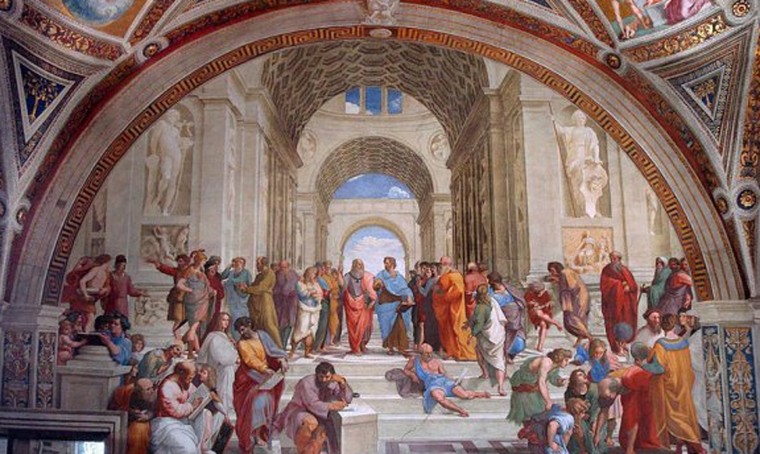 Raphael, School of Athens, 1509-1511, Fresco, Apostolic Palace in the Vatican
Raphael, School of Athens, 1509-1511, Fresco, Apostolic Palace in the Vatican
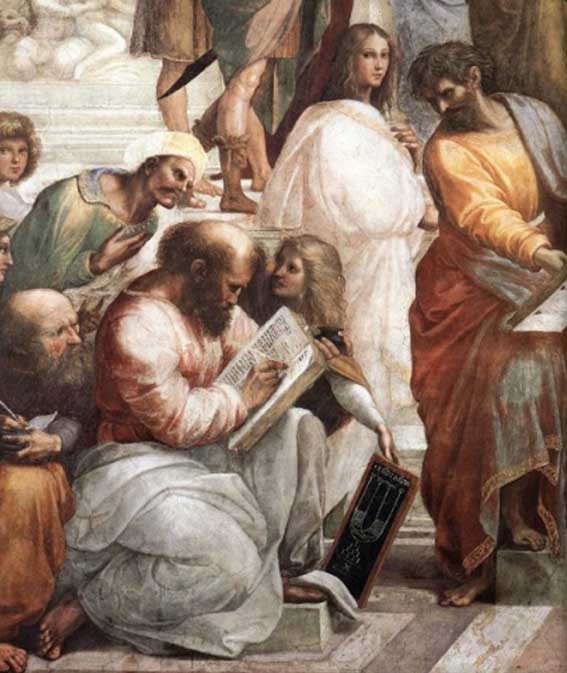 Raphael, Detail from School of Athens (Pythagoras)
Raphael, Detail from School of Athens (Pythagoras)
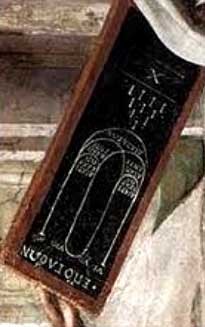 Raphael, Further Detail, Pythagorean Theorem Inverted
Raphael, Further Detail, Pythagorean Theorem Inverted
SP: It’s fantastic to see someone still consciously using these very ancient ideas in what is ultimately very ‘modern’ art. And in some ways the impression I have of Duncan Moon is that he is a traditionalist, and to take off on a bit of a tangent from that, in some ways a real old-skool artist, who has taken art almost as a trade, and has had to learn building skills along the way. I bet you could probably build a house, for instance, by now. I get the impression that, in order to manifest your ideas, you’ve had to learn many crafts along the way. Do you enjoy working with what are traditional building materials?
DM: I think you’re right, yes I’m old-skool. The atelier model works for me, although I never experienced it in any training. I’m what would have been called in days gone by an artificer – an artist / artisan, a maker of things. Ateliers were workshops that made other stuff beyond paintings and sculptures as these disciplines provided the basis for divergence.
There’s the perception that the artist is a hopelessly impractical person, unable to fully integrate with society because they have an invisible birth defect in that they were born without a left lobe to their brain and require special dispensations. So to ameliorate this I ply my trade, which is both art and craft. I draw, paint and design, measure and cut, fashion, fabricate and manifest from accurate drawings to accurate reality. This workmanlike attitude was advised by Monet, who insisted the artist be in his/her studio by 9 am (slacker ̶ I start between 6 and 7!), and Woody Allen, who said, ‘Just turn up!’ It’s an approach to work/art/artwork that helps ground me and keep me single-minded, focused etc, and this is necessary because my ideas are very involved and pretty out there, and the work load is horrendous.
I do enjoy working with traditional materials and hand tools – hammers and chisels and hawks and trowels have been around and largely unchanged for millennia. Lime mortar is a great material that works in a fulfilled cycle. I also use hi-tech modern materials to solve structural problems in restoration work; this is always finished with traditional materials, however. Stone has held me in its thrall for most of my life.
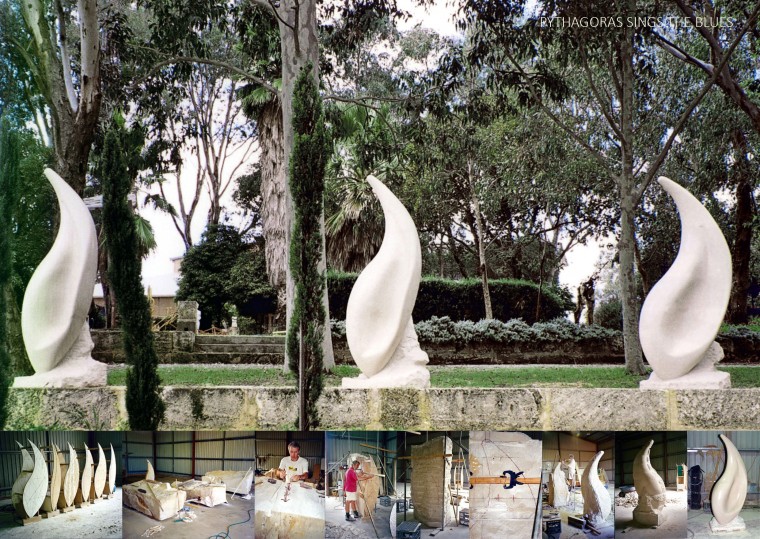 Duncan Moon, Pythagoras Sings the Blues
Duncan Moon, Pythagoras Sings the Blues
SP: I’ve just seen a picture of the most recent developments of ‘The Nearest of the Faraway Places,’ and I want to ask you a really silly and obvious question that maybe a child would ask: what is it?
DM: The current project is a toilet block refurbishment that complements the site overall by entering into a direct dialogue with the wetlands fauna and flora. Water birds (egrets), plants (kangaroo paw) and tortoise forms (western swamp tortoise is presently the most endangered reptile in Western Australia) are evoked into a new architecture governed by overt and covert sublime geometry that is a facsimile of the numbers found in nature. My objective is to create a profound eurhythmic relationship between place and the parts and the whole of the building. A humble public utility will find visual redemption in Platonic form, ably correspond with its environment, and elevate the prosaic experience of answering a call of nature. An aesthetically delightful pavilion ̶ that would be an hallucinatory experience were it not for functional necessity ̶ will become an exotic destination: the Nearest of the Faraway Places. (Making an exotic destination of a utility, and a sly reference to body parts).
SP: While looking at the recent pictures of the toilet block, and some of the stone textures, I was reminded of the whole fact of colour. Do you intend to paint it? Many early classical sculptures, and even the Parthenon, show vestiges of paint. You will know this, of course. Maybe we are all too familiarised with the bare stone now, and it would be too intense for our tastes, but did you consider it on this one? Or is it heading that way?
DM: The toilet block will be partially painted – the square panels, cornice moulding and egret ‘caryatids’ will be painted a calm blue/grey/white with a darker tone used in specific places and the stone, which is all rather muted and earthy, left alone. The insides of the screen walls however will be painted screaming, electric blue and pink, these will be the only semiotics for male and female – corny, universal and immediate.
SP: I think perhaps we should leave those wonderful and unexpected screaming electric blue and pink … semiotics for male and female to resound and echo through the pages of Triggerfish… Duncan Moon, thanks very much for doing the interview. It’s been an education. For those interested in learning more, here’s a recent radio interview: https://radio.abc.net.au/programitem/pgdGoPA3K6?play=true,
and also a link to his website: http://duncanmoon.com/
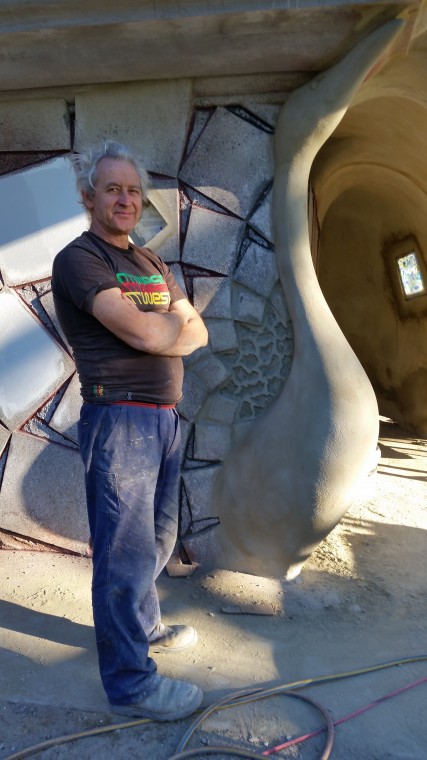 Duncan Moon, Work-in-Progress (The Nearest of the Faraway Places)
Duncan Moon, Work-in-Progress (The Nearest of the Faraway Places)

